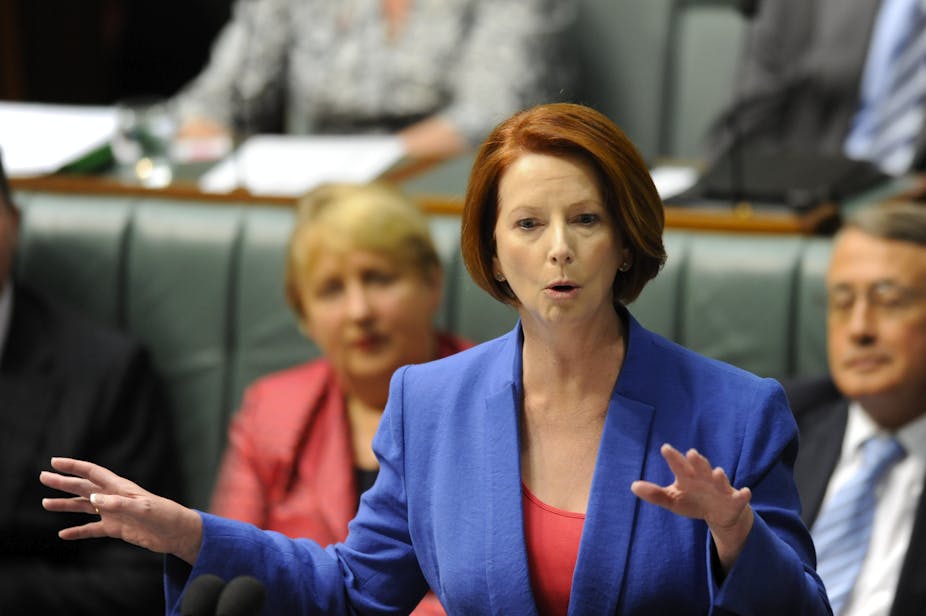As the fallout from Julia Gillard’s speech on Tuesday afternoon dies down, I find myself watching the footage again and again. While her words were compelling, the sting in the Prime Minister’s performance was in her delivery.
The theatrics of it demonstrated what could be a new Gillard, a stateswoman of international calibre. Abbott’s response — in his posture, gesture and facial expression — was unfortunately in keeping with past embarrassments.
Gillard: 1, Abbott: 0
In the misogyny speech, the prime minister’s body language was unusually impassioned.
The delivery was cleverly orchestrated, right down to the strategically shifting eye gaze. Making too much direct eye contact with Abbott or other shadow cabinet members would risk an offensive level of attack. A generalised gaze into the middle distance would not give enough personal impact. The short but direct eye contact with various members of her own party, the opposition, backbenchers and frontbenchers instead added force to her speech.
Abbott, on the other hand, behaved predictably. In recent years, the frequency of Abbott’s verbal faux pas may have reduced slightly, but he still frequently communicates ill-advised responses, both verbal and non-verbal that hurt his and his party’s image. When he does stay on message, Abbott’s non-verbal gestures can contradict his words, presenting an image of conflicted, and therefore ineffective, conservative leadership.
During the misogyny debate, Abbott’s facial expression and posture amounted to an open admission of guilt.
Although at the start of the 15 minutes of Gillard’s speech, the leader of the opposition attempted an air of amused tolerance, this fizzled into a display of frowns, looking down and he can be seen sinking ever lower in his chair. Abbott may have recently learned the “Howard pout” (chin up, lips out) from his mentor, but he is yet to emulate Howard’s impenetrable Teflon attitude in Parliament.
Goodbye to old Labor rules?
Gillard’s delivery in question time could signal a shift in Labor Party public relations; let’s hope so. Labor representatives of recent years have used what I call a “talking heads” approach to public speaking.
The Labor Party has tried to focus all media attention on their candidates’ words, with minimal distraction from body language, gesture and facial expression. In this style of delivery, the shoulders remain back, while the hands remain on the lectern with, at the very most, an occasional arm wave. The facial expression remains neutral, smiles and surprise are rare. Jabbing the head forward in a painful-looking manner is the main means of emphasis.
In this style, all evidence that the candidates have personalities and histories beyond the reaches of the party machine is shut away. The overall effect is extremely dull, not to mention a waste of communicative resources.
Only two years ago Gillard’s speeches followed this pattern, her speech on first taking office is a classic example. Kevin Rudd was, and remains, a great proponent of this wooden, reveal-nothing style. Similarly, Bill Shorten, one of the infamous “faceless men”, has also relied on this approach his various performances during television interviews.
Leaving the party line behind
The Gillard speech on misogyny broke the talking heads mould with panache. In this speech, there was none of the typical Labor physical restraint.
Gillard waved both hands, pointed, and even moved her feet. She made jokes, and most importantly, seemed to care. When she stood in a defiant, strong stance, stared at Abbott and said “my father did not die of shame”, her emotion was clear for all to see, however controlled. We could see, and more importantly feel the plea for decency and recognition of past wrongdoing.
It is this that made Gillard more likable overnight, in Australia and internationally. The delivery of the misogyny speech shows Gillard as more than a great deal-maker, and more than a political animal; this speech showed us she’s human.

